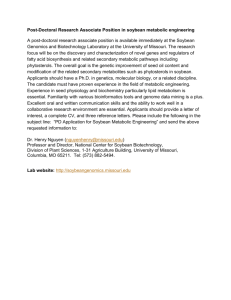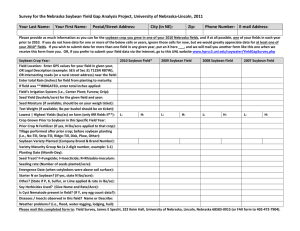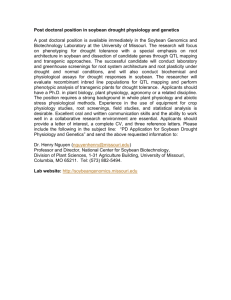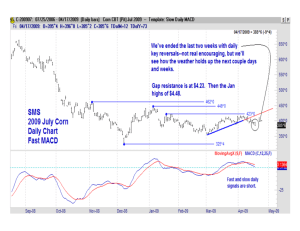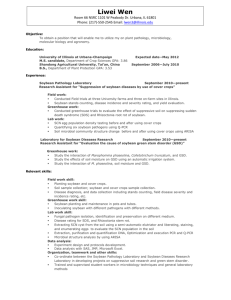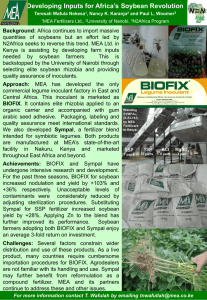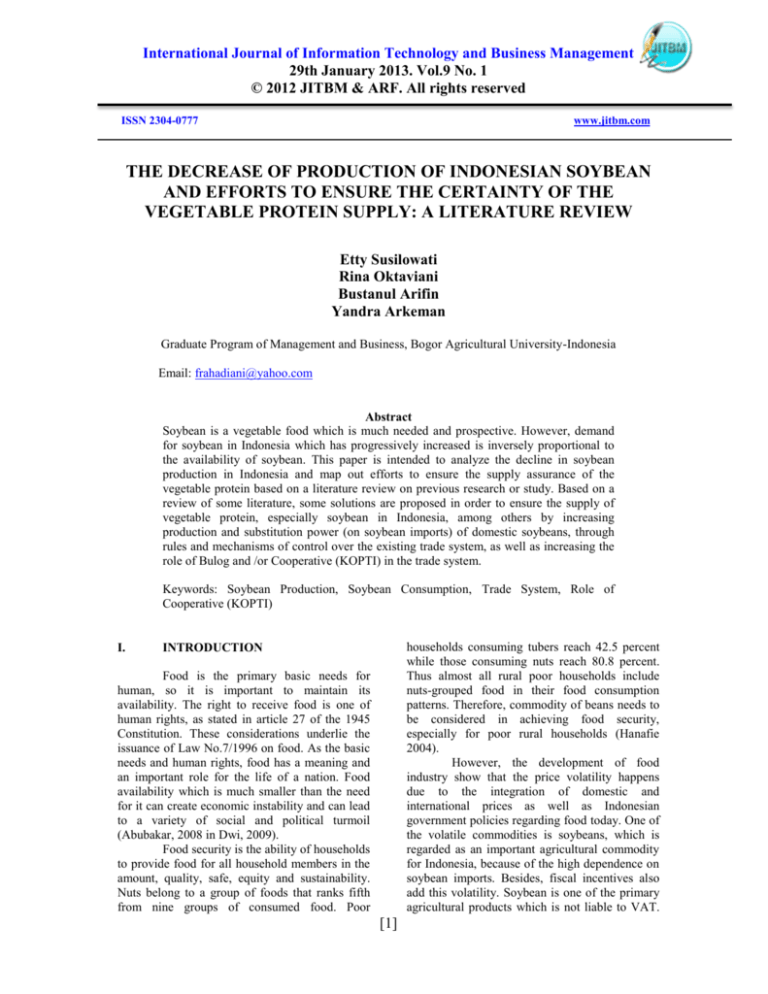
International Journal of Information Technology and Business Management
29th January 2013. Vol.9 No. 1
© 2012 JITBM & ARF. All rights reserved
ISSN 2304-0777
www.jitbm.com
THE DECREASE OF PRODUCTION OF INDONESIAN SOYBEAN
AND EFFORTS TO ENSURE THE CERTAINTY OF THE
VEGETABLE PROTEIN SUPPLY: A LITERATURE REVIEW
Etty Susilowati
Rina Oktaviani
Bustanul Arifin
Yandra Arkeman
Graduate Program of Management and Business, Bogor Agricultural University-Indonesia
Email: frahadiani@yahoo.com
Abstract
Soybean is a vegetable food which is much needed and prospective. However, demand
for soybean in Indonesia which has progressively increased is inversely proportional to
the availability of soybean. This paper is intended to analyze the decline in soybean
production in Indonesia and map out efforts to ensure the supply assurance of the
vegetable protein based on a literature review on previous research or study. Based on a
review of some literature, some solutions are proposed in order to ensure the supply of
vegetable protein, especially soybean in Indonesia, among others by increasing
production and substitution power (on soybean imports) of domestic soybeans, through
rules and mechanisms of control over the existing trade system, as well as increasing the
role of Bulog and /or Cooperative (KOPTI) in the trade system.
Keywords: Soybean Production, Soybean Consumption, Trade System, Role of
Cooperative (KOPTI)
I.
households consuming tubers reach 42.5 percent
while those consuming nuts reach 80.8 percent.
Thus almost all rural poor households include
nuts-grouped food in their food consumption
patterns. Therefore, commodity of beans needs to
be considered in achieving food security,
especially for poor rural households (Hanafie
2004).
However, the development of food
industry show that the price volatility happens
due to the integration of domestic and
international prices as well as Indonesian
government policies regarding food today. One of
the volatile commodities is soybeans, which is
regarded as an important agricultural commodity
for Indonesia, because of the high dependence on
soybean imports. Besides, fiscal incentives also
add this volatility. Soybean is one of the primary
agricultural products which is not liable to VAT.
INTRODUCTION
Food is the primary basic needs for
human, so it is important to maintain its
availability. The right to receive food is one of
human rights, as stated in article 27 of the 1945
Constitution. These considerations underlie the
issuance of Law No.7/1996 on food. As the basic
needs and human rights, food has a meaning and
an important role for the life of a nation. Food
availability which is much smaller than the need
for it can create economic instability and can lead
to a variety of social and political turmoil
(Abubakar, 2008 in Dwi, 2009).
Food security is the ability of households
to provide food for all household members in the
amount, quality, safe, equity and sustainability.
Nuts belong to a group of foods that ranks fifth
from nine groups of consumed food. Poor
[1]
International Journal of Information Technology and Business Management
29th January 2013. Vol.9 No. 1
© 2012 JITBM & ARF. All rights reserved
ISSN 2304-0777
www.jitbm.com
In addition, there is also an adjustment on the
import duty rate on soybeans, from originally 0%
to 5%.
The demand for soybean in Indonesia
progressively increases (Ahahermanto, 2012). It
is inversely proportional to the availability of
soybean in Indonesia. This suggests that soybean
is a vegetable food that is desperately needed and
prospective. Of the total supply of soybeans in
Indonesia, both imported and domestic, 70% is
for tofu and tempeh and 30% for other food
needs.
The condition of excess demand for
soybean in the soybean market causes Indonesia
to rely heavily on imports. Supadi (2009)
recorded a growth of Indonesia's dependence on
imported soybeans was higher year-over-year
from 1978 to 2006, even from 1998 to 2006,
reaching the level of dependency of 54.66% and
after 2006 more than 60%. The price of imported
soybeans is cheaper than local production so that
farmers in Indonesia are more reluctant to plant
soybeans. Local soybean may not be able to
compete with imported soybean, both in price and
quality. Thus, there is no incentive for farmers to
plant soybeans, mainly because there is no
guarantee for the prices during the harvest season.
For this reason, this paper is intended to
analyze the decline in soybean production in
Indonesia and map out efforts to ensure the
certainty of supply of the vegetable protein based
on literature review on previous research or study.
as the biggest supplier of soybean imports to
Indonesia are the United States (66 percent),
Argentina (5 percent), Malaysia (4 percent),
Canada and Singapore (1 percent). Indonesia has
kept increasing its imports since the radical
liberalization due to the pressure from the IMF in
1998.
The import policy includes greatly when
the government, through the Minister of Industry
and Trade Sector 406/Kep/II/1997 removed
soybean trading system which was originally
handled by Bulog transferred to the General
Importer. This is in accordance with the wishes of
the World Trade Organization (WTO) and the
International Monetary Fund (IMF) on the
grounds to help small and medium entrepreneurs
in obtaining raw materials soybean (Hadi and
Wiryono, 2005).
Freely importing soybean makes the
soybean price in the domestic market under
pressure. The increase of soybean imports has an
effect on the decline in domestic soybean
production. The decline in domestic production
has happened since 1993 and the production has
declined sharply since 2000. In stabilizing the
domestic soybean price, at the beginning of the
eighties Bulog implement procurement and
distribution of soybean. The aim is to ensure the
availability of soybeans for tofu/tempeh,
especially for the members of PRIM KOPTI.
Procurement of domestic soybean only took place
in 1979/80 - 1982/83 in the amount of less than 1
percent of domestic production. Instead,
procurement through imports takes place every
year in large quantities and at lower prices.
Before the economic crisis, the price set by Bulog
generally slightly higher than import prices, so as
to support the local soybean prices (Amang,
1996).
Since Bulog's role as a government trade
agency for soybean was revoked in 1998, all
traders in agribusiness can trade soybeans with 0
per cent import duty, VAT of 10 percent and 2.5
percent. Although in Mei 2002 the government
established a mechanism of NPIK (Identification
Number for Special Importer) to reduce soybean
imports, but its effectiveness is still weak to
control the imports (P2HP, 2005).
Other international trade policy is an advalorem tariff for imported soybeans. The rates
were applied from 1974 to 1982 by 30 percent.
From 1983 to 1993 soybean import tariffs were
II. LITERATURE BACKGROUND
2. 1 Policies on Imported Soybean Trade
The objectives of agricultural trade
policy may vary depending on the commodity.
For example, policy on import duty tariff or on
non-tariff barriers aims at protecting import
substitution commodities. Instead, tax policy or
restrictions on exported goods are intended to
fulfill domestic needs or prevent the rise in
commodity prices in the country. Domestic trade
policy generally aims to facilitate or hinder the
marketing of commodities between regions
(Simatupang, 1989).
Import of soybean Indonesia each year
began to increase and it has increased sharply
since 1999. According to the Directorate General
of P2HP, Department of Agriculture (2004), from
2000 to 2004 the order of ranks of the countries
[2]
International Journal of Information Technology and Business Management
29th January 2013. Vol.9 No. 1
© 2012 JITBM & ARF. All rights reserved
ISSN 2304-0777
www.jitbm.com
lowered to 10 percent and then to 5 percent from
1994 to 1996. In 1997 the rates were lowered
again to 2.5 percent and eventually the tariffs
were eliminated from 1998 to 2003. In 2004 the
government reestablished the tariffs to 5 percent,
and from January 1, 2005 through 2010 to 10
percent. Import tariff policy usually will raise the
soybean prices in the country including producer
prices (P2HP, 2005).
Fahma (2007) even predicted that there will be a
shortfall of soybean supply in 2004, 2007, 2010
and 2013. Accordingly, Soybean development
program in the long run is to increase domestic
production in order to reduce imports to meet the
needs of the industry that has grown nowadays
(Fahma, 2007; Supadi. 2009)
2. 2 Supply and Demand of Imported Soybean
By looking at a large enough imbalances
between demand and supply of soybean in
Indonesia, some researchers conduct studies by a
variety of methods to provide recommendations
in order to meet the needs of vegetable protein
supply particularly soybean. Some researchers
analyzed directly the market (demand and supply)
of soybean in Indonesia, among others
Rachmawati (1999), Purnamasari (2006),
Khusrizal and Jamilah (2007), Fahma (2007), as
well as Supadi (2009).
Research conducted by Rachmawati
(1999) focuses on the analysis of soybean trade in
Indonesia, especially those associated with
imported
soybean,
policy
and
market
opportunities, and soy consumption in Indonesia.
The approach taken is to use the Armington
model assuming that Indonesian consumers see
the soybean from the U.S., Brazil, Argentina and
other areas as a product which is different from
each other. Racmawati (1999) proposed a solution
to the problems of soybean trade in Indonesia,
namely the implementation of programs to
enhance the substitution power of local soybean
such as development of soybean seed preferred by
farmers and producers of tofu and tempeh.
The research conducted by Purnamasari
(2006) examined factors that affect the production
and soybean imports in Indonesia. The method
used in this research is the theory of supply and
demand and the theory of production as well. By
using the methods the study yields that the
development of soybean production in 1984-1993
showed an increasing trend. The things that affect
the import of soybean in Indonesia include the
width planting area, the diminishing of
productivity of soybean and soybean real price at
the producer level in the domestic market. This
study suggests the need for strategies to improve
the national soybean production through
increased productivity and expansion of planting
area. In addition, government intervention is also
III. DISCUSSION AND ANALYSIS
Siregar (2012) stated that based RPJMN
2010-2014, the priority of food security was set
through food production growth target per year, ie
3.2% for rice, 10.02% for corn, 20.05% for
soybeans, 12.25% for sugar, and 7.3% for beef.
Total production of rice, soybean, and corn shows
an increase from 2006, and is predicted to
increase as well in 2012.
P2HP (2005) stated that domestic
soybean production was still far below the
number of domestic demand. In 1990, domestic
production was able to fill domestic market
approximately 83.32 percent, and the remaining
26.68 percent was imported. The capability of
domestic production to fill the domestic market
increasingly declines; after 2000 more than 50
percent of domestic needs are met by imports, and
even in 2004 the imports reached 65 percent. The
domestic market share is estimated keep growing
by the increase of demand on soybean and soy
derivatives. Although the productivity is still low,
on the level of prices relatively stable (IRD
3.000/kg) soybean agricultural enterprise is
financially quite profitable, at IRD 2.05
million/ha at the B/C 2.14. However, these
enterprises have not been able to compete to raise
the substitution of imported soybean. Supadi
(2009) even stated that the growth of Indonesia's
dependence on imported soybean kept higher
year-over-year from 1978 to 2006, even from
1998 to 2006, reaching the level of dependency of
54.66% and after 2006 more than 60%.
Therefore,
the
improvement
of
productivity is one way to improve the
competitiveness of these commodities. Soy-based
industries that have grown are the industries of
tempeh, tauco, soy sauce, tofu, and milk.
However, Indonesian soybean production is only
able to meet about 35 percent of the need, and as
much as 55 percent of that is still imported.
[3]
International Journal of Information Technology and Business Management
29th January 2013. Vol.9 No. 1
© 2012 JITBM & ARF. All rights reserved
ISSN 2304-0777
www.jitbm.com
necessary to mitigate the negative impact of trade
liberalization on the welfare of producers.
Strategies for distribution and marketing are also
needed to enhance the competitive advantage of
soybean commodity in inter-regional trade,
import substitution and export promotion.
Furthermore, Khusrizal and Jamilah
(2007) conducted research on the import tariff of
soybean in Indonesia. This study focused on the
performance of the policies of soybean import
tariff on the supply and demand of soybean in
Indonesia. This study uses secondary data, time
series in 1969-2002. The entanglement of import
tariff and non tariff on demand, supply, prices,
and imports of soybean were analyzed by
building a dynamic econometric model in a
system of simultaneous equations. The model in
this research is used to gain the influence of
imports tariff policies on demand, supply, prices,
and imports of soybean in Indonesia. Khusrizal
and Jamilah (2007) suggested the need for
revamping of the management of imported food
commodities, including through increasing the
domestic soybean production.
Fahma (2007) by using a two stage least
square analysis, with demand and supply models
projected the supply and demand of soybean over
the past ten years (2004 s/d2013) and found that
there is the shortage of supply of soybean in
2004, 2007, 2010 and 2013. With case studies on
the distribution system of soybean commodity in
the district of Grobogan, it is proposed the need
for action to deal with the shortage of soybean
supply by increasing the number of domestic
soybean production and the need to improve the
role of KOPTI in order to maintain the price
stability.
The research by Supadi (2009) is about
the continuing impact of soybean imports to food
security. The method used in this research was
descriptive analysis. This study examined the
impact of soybean import dependence to national
food security. Policies to increase soybean
production are needed to provide intensive,
especially prices for farmers as well as to be
efforts to build food security. The results of this
study suggest the need to provide protection and
security to farmers concerning soybean prices,
planting area expansion and increasing
productivity, improving infrastructure (physical
and institutional), the effectiveness of counseling
associated with research, involving the private
sector in partnership with farmers and farmers'
groups, and the need to regulate the trade system
of soybean and to repose the role of Bulog
through strict control mechanisms.
Based on these studies, it can be seen
that the demand for soybean in Indonesia has
progressively increased. The increase is inversely
proportional to the availability of soybean in
Indonesia. Indonesia's soybean market is
currently highly dependent on imports; this
situation needs to be addressed with integrative
strategies. From the supply side, production and
the power of substitution (on the imported
soybean) of domestic soybean need to be
improved. Meanwhile, from the supply chain
side, there is a need for rules and control
mechanisms over the existing trade system, as
well as a need to improve the role of Bulog and/or
Cooperative (KOPTI) in the trade system. In this
regard, government intervention is necessary.
IV.
CONCLUSION
Soybean is a vegetable food which is
much needed and prospective. However, demand
for soybean in Indonesia which has progressively
increased is inversely proportional to the
availability of soybean. Based on a review of
some literature, some solutions are proposed in
order to ensure the supply of vegetable protein,
especially soybean in Indonesia, among others by
increasing production and substitution power (on
soybean imports) of domestic soybeans, through
rules and mechanisms of control over the existing
trade system, as well as increasing the role of
Bulog and/or Cooperative (KOPTI) in the trade
system. Institutional integrative solutions in the
supply chain become important to follow up.
Furthermore, based on these proposals
the role of KOPTI in the supply chain of soybean
is quite significant. However, the current
condition indicates that the KOPTI has a serious
problem which even tends to a crisis, especially
on the institutional aspects that need ongoing
efforts to restore the continuity of their business
or to make it more resilient to market conditions.
Further research on the institutional aspects and
resilience of businesses of KOPTI is required in
order to provide practical solutions for the system
and good business management for KOPTI so
that the continuity of the business and certainty of
[4]
International Journal of Information Technology and Business Management
29th January 2013. Vol.9 No. 1
© 2012 JITBM & ARF. All rights reserved
ISSN 2304-0777
www.jitbm.com
supply of vegetable protein in Indonesia can be
guaranteed.
10.
REFERENCES
1.
2.
3.
4.
5.
6.
7.
8.
9.
Abubakar M. 2008. “Kebijakan Pangan,
Peran Perum Bulog dan Kesejahteraan
Petani”. Dalam: Agnes Aulia Dwi.
Analisis Daya Saing dan Strategi
Pengembangan Agribisnis Gandum
Lokal di Indonesia. Thesis. Bogor:
Fakultas Ekonomi dan Manajemen,
Institut Pertanian Bogor.
Ahahermanto.
2012.
“Analisa
Permintaan dan Penawaran Kedelai”.
Accessed
26
of
July
2012:
.http://ahahermanto.wordpress.com/2012
/05/05/analisa.permintaan.dan.penawara
n
Amang, B. 1996. “Ekonomi Kedelai di
Indonesia”. IPB Press. Bogor.
Directorate
General
of
P2HP,
Department of Agriculture [P2HP].
2004. “Situasi Perdagangan Internasional
Kedelai”. Ditjen P2HP, Jakarta.
Directorate
General
of
P2HP,
Department of Agriculture [P2HP].
2005.
“Kebijakan
Tataniaga
Perdagangan
Komoditas
Kedelai”.
Ditjen P2HP, Jakarta.
Hadi, P.U. dan B. Wiryono. 2005.
“Dampak Kebijakan Proteksi terhadap
Ekonomi Beras di Indonesia”. Jurnal
Agro Ekonomi, Vol. 23. No. 2. Pusat
Penelitian dan Pengembangan Sosial
Ekonomi Pertanian, Bogor.
Hanafie, R. 2004. “Tingkat Konsumsi
Kacang-kacangan dan Umbi-umbian
sebagai Pendukung Ketahanan Pangan”.
Dalam: Makarim AK. et.al, editor:
Kinerja Pelatihan Mendukung Agribisnis
Kacang-Kacangan dan Umbi-Umbian.
Bogor:
Badan
Penelitian
dan
Pengembangan Pertanian. Pp. 592-602.
Fahma, Fakhrina, 2007, “Perancangan
Model Supply Demand Kedelai sebagai
Dasar Pengembangan Industri Berbasis
Kedelai di Kabupaten Grobogan Jawa
Tengah”, Gema Teknik, No. 1, Tahun X
Khuzrizal & Jamilah. 2007. “Kebijakan
Tarif Impor Kedelai di Indonesia
(Analisis Simulasi Historis Permintaan
11.
12.
13.
14.
[5]
dan Penawaran Kedelai”, Manajemen
Akuntansi dan Bisnis, Vol. 5, No. 3.
Purnamasari, R. 2006. “Analisis faktorfaktor yang mempengaruhi produksi dan
impor kedelai di indonesia”. Thesis.
Bogor: Fakultas Pertanian, IPB.
Rachmawati, M. 1999. “Analisis
perdagangan kedelai di indonesia”.
Thesis. Bogor: Fakultas Pertanian, IPB.
Simatupang,
P.
2003.
“Analisis
Kebijakan: Konsep Dasar dan Prosedur
Pelaksanaan”. Jurnal Analisis Kebijakan
Pertanian. Vol. 1. No. 1. Pusat
Penelitian dan Pengembangan Sosial
Ekonomi Pertanian. Bogor.
Siregar, Mahendra, 2012, “Connectivity
and Infrastructure towards Sustainable
Agriculture Development”, presented in
the National Seminar of “FEED THE
WORLD” Jakarta Food Security Summit
2012
Supadi. 2009. “Dampak Impor Kedelai
Berkelanjutan
terhadap
ketahanan
pangan”, Analisis Kebijakan Pertanian,
Vol 7, No 1, pp.87-102.



